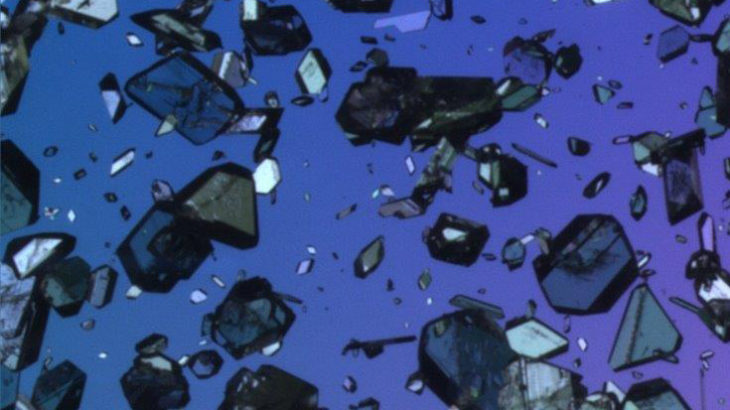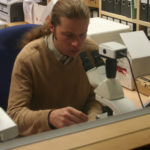Making the Structure of Materials Crystal Clear

Exposing the deepest, most revealing secrets of materials’ structure is all part of a day’s work at the UK National Crystallography Service (NCS), based at the University of Southampton.
By firing X-ray beams at crystals often just one-hundredth the size of a salt grain and then measuring the radiation’s diffraction pattern, Professor Simon Coles and his team generate important insights into materials and their properties – facilitating development of, for example, new drugs and novel energy storage technologies.
This cutting-edge service provides UK academia and industry with easy access to world-class crystallography skills and facilities, opening the door to discovery and innovation and helping to keep the UK right at the forefront of pioneering science.
Facilities with the X Factor
The roots of crystallography lie in Wilhelm Röntgen’s ground-breaking discovery of X-rays in 1895. But it wasn’t until 1913 that father-and-son team William Henry and William Laurence Bragg first formulated the relationship between the atomic structure of a crystal and the way that X-rays change direction, or ‘diffract’, when they strike it. The following decades duly saw crystallography evolve from fledging technology to proven discipline as it began to shed unique light on everything from proteins and enzymes to viruses and DNA – the building block of life.“The NCS was first established in 1981 and has been located here at Southampton since 1998,” says Professor Coles. “Over that time it’s evolved into an internationally renowned, genuinely world-leading facility, available to UK academic researchers free at the point of access and to industrial users at very affordable commercial rates. The Engineering and Physical Sciences Research Council (EPSRC) recently renewed our grant for three years and this, along with support from the University of Southampton, has allowed us to upgrade our suite of X-ray diffraction measurement devices”.
Complementing its utilisation of Diamond Light Source (the UK’s national synchrotron facility in Oxfordshire), the NCS offers four high-power diffractometers housed in Southampton University’s Chemical Crystallography Laboratory:
- ‘Ros’ – an ultra-high-flux diffractometer named after crystallography pioneer Rosalind Franklin and possibly the world’s most powerful lab-based machine of its kind.
- ‘Kat’ – a very-high-flux diffractometer named in honour of Dame Kathleen Lonsdale, one of the first two female scientists elected as Fellows of the Royal Society.
- ‘Dot’ – a high-flux diffractometer named after Dorothy Hodgkin, a Nobel Prize winner who first developed protein crystallography.
These formidable facilities provide the basis for one of the most powerful, highest-throughput crystallography labs in the world. But it’s not simply a question of using ‘kit’ to collect diffraction data from all kinds of crystals – including radioactive, biohazardous and air-sensitive samples – as Simon Coles explains: “Not all of our users have the in-house capabilities to analyse the data we generate, so we also offer full structural analysis of samples and a range of tailored training support to help users secure the best possible understanding of the data we obtain. We also offer a range of advanced techniques and can help with design of experiments and collaborative projects. Everything we do is geared to delivering maximum value from the service.”
Shares in Success
The NCS is an outstanding example of how operating across organisational barriers can make a tangible difference to outcomes from high-quality research. “The service is essentially a shared resource for the UK’s chemistry community,” Simon Coles says. “Individually, our users simply wouldn’t find it cost-effective to acquire, develop and maintain the quality of equipment and expertise that we, as a national, centrally funded service, can provide.”The real-world benefits are hard to overestimate. Determining how atoms and molecules are arranged is a key step towards understanding a material’s properties, its behaviour and therefore its potential uses. For example, which drug candidates could be developed into practical therapies and how would they behave when they’re inside a patient’s body? How can the structure of organic molecules be arranged to enhance their ability to store energy and provide better battery technology for mobile phones and other devices in future?“Crystallography helps to provide answers to all kinds of crucial questions,” explains Professor Coles. “It needs to be part and parcel of the science toolkit of any nation that aspires to be and to remain a world leader in invention and innovation – and that’s precisely what we’re ensuring here at the NCS.”
A User’s View
The wide-ranging roster of NCS users includes every member of the SES consortium. To take just one example, the School of Biological and Chemical Sciences at Queen Mary University of London (QMUL) – the NCS’s home when it was first set up – typically uses the service around half a dozen times a year. Dr Isaac Abrahams, Senior Lecturer, sums up the benefits:
“It’s impossible to overstate the value of easy access to a national service of this calibre”
Dr Isaac Abrahams, School of Biological and Chemical Sciences, QMUL
“We harness crystallography to study all kinds of potentially useful materials: fullerenes for solar cells, catalysts, biomimetic compounds, biomedical materials, materials for electronic devices and so on. Although we have a standard diffractometer in-house, sometimes we need more specialised capabilities that also deliver fast turn-round times. We might want to examine very tiny or very weakly diffracting crystals, or need a high-intensity X-ray source to investigate a particular type of lattice structure. Alternatively, we might need back-up for our in-house facility during a period of high demand. These are all situations where the NCS really comes into its own and the fact that it offers access to Diamond Light Source is a major bonus. It’s impossible to overstate the value of easy access to a national service of this calibre in terms of accelerating the journey to insight and innovation.”
Further Information
Article on the history and future of the NCS
Press release on last round of funding (Nov 2016)
- Coles S.J., Allan D.R., Beavers C.M., Teat S.J., Holgate S.J.W., Tovee C.A. (2020) Leading Edge Chemical Crystallography Service Provision and Its Impact on Crystallographic Data Science in the Twenty-First Century. In: Mingos D.M.P., Raithby P.R. (eds) 21st Century Challenges in Chemical Crystallography I. Structure and Bonding, vol 185. Springer, Cham.
- Coles, S.J. and Gale, P.A. Changing and Challenging Times for Service Crystallography. Chem. Sci., 2012, 3 (3), 683-689.
- Hursthouse, M.B. and Coles, S.J. The UK National Crystallography Service; Its Origins, Methods and Science, (2014). Crystallography Reviews, 20:2, 117-154.

Professor Simon Coles
Director, UK National Crystallography Service, School of Chemistry, University of Southampton

